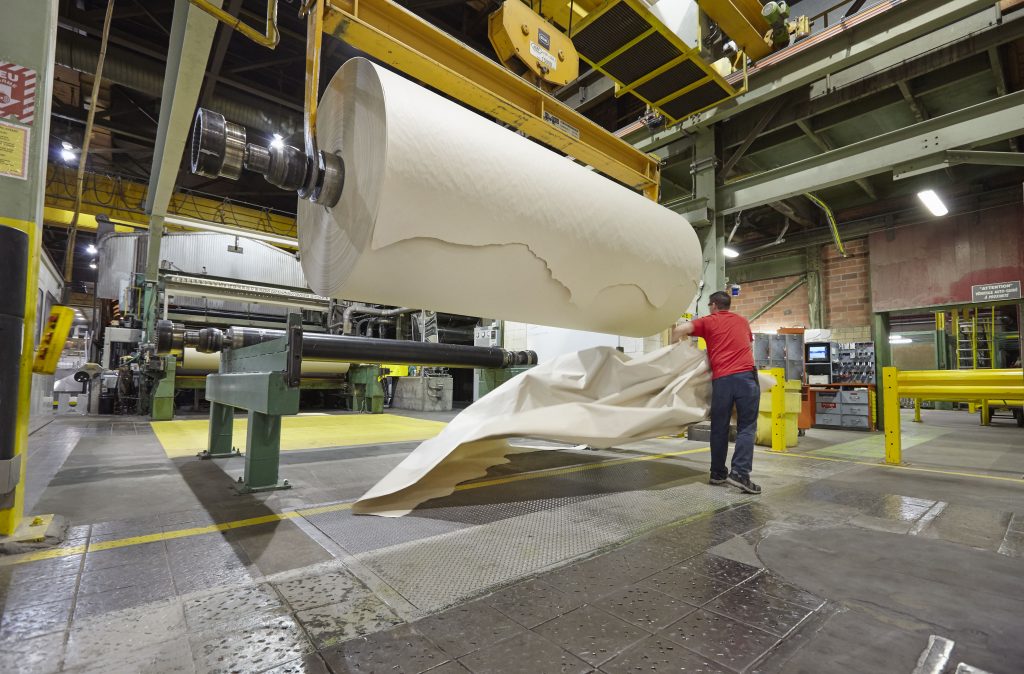
Features
Equipment & Systems
Paper
Solving the riddle of an off-quality paper problem
July 13, 2020 By Silvia Cademartori
 Rolland Paper's paper winder in Saint-Jérôme, Quebec. Photo: Sustana Group
Rolland Paper's paper winder in Saint-Jérôme, Quebec. Photo: Sustana Group I can appear before or after printing and converting, or at the end use. I react to moisture changes and can be a seasonal or a regional challenge. I am a well-known issue yet looking for victims. What am I?
If you answered paper curl, you’re right. We’ve all dealt with paper curl at one time. Maybe it was while reading the newspaper or printing from the office printer, or right on the front line at the paper mill or dealing with the curl issue for a customer. Left to be, paper curl will not lie flat and will start winding up in one direction or begin twisting.
FPInnovations and Kruger paper experts recently set the facts straight about paper curl. Frédéric Parent, paper and consumer products manager at FPInnovations, and Javad-Reza Saberian, senior advisor, product diversification at Kruger, presented their combined research and case studies at the 2020 PaperWeek Canada conference in Montreal. They also led a roundtable discussion with industry peers.
Paper curl affects the bottom line of the pulp and paper sector across the value chain from mills and converters to end users, such as printing and writing grades, specialty papers and packaging products. The costs of customer claims, returned inventory and increased transportation add up.
What are the causes of paper curl? Why does it happen?
In general, paper tends to expand or shrink when it absorbs or loses moisture due to changes in ambient humidity or due to converting and printing. If this expansion is different on the top side versus the bottom side of the paper, curl can happen. For example, both photocopy machine paper and newspaper may curl, but due to different reasons: different type of paper, different processes and different causes.
Several factors cause paper curl. How do you identify the cause or origin of the curl?
It is possible to discover the source of the curl when using a proper measuring tool and ambient humidity cycling. Normally with exposure to high ambient humidity, the retained drying stresses in the sheet are released, so we can evaluate the contribution of uneven drying between the top and bottom sides of the sheet.
Through moisture cycling, the potential contribution of structural two-sidedness can also be identified. Structural two-sidedness could be related to a non-uniform distribution of fibre orientation, fines or sheet density in the thickness direction.
Is paper curl preventable?
The curl at the end use is dependent not only on the curl tendency of the paper but also on the converting process and end use. While the mills focus on reducing the curl tendency of their paper, it is good to consider any changes in the customer’s behaviour and operation that could potentially impact the final curl after converting.
Depending on the issue, paper curl can be prevented if we know the mechanisms behind the curl in advance. Some mills have defined appropriate corrective actions based on the different causes. Seasonal factors are the most critical to consider when attempting to prevent curl.
Can paper curl be reversed?
Paper curl are of two types: reversible and irreversible. The reversible curl can be reversed depending on the relative humidity at which the paper is exposed. Too high or too low relative moisture will amplify the issue. As for irreversible curl, as its name suggests, it cannot be remedied or reversed.
Why are some curls irreversible?
The irreversible curl cannot be reversed because it is related to drying stresses that are relaxed when the paper is exposed to excessive relative humidity changes. Once these stresses are relaxed, the paper remains curled. This type of curl is usually more present with single-felt dryer sections.
How can paper curl be minimized?
If mills can figure out the root cause of paper curl, it becomes easier for them to adjust the corresponding key parameters on the paper machine.
Depending on the nature of the curl, some papermaking operations can be modified to reduce curling: Certain changes at the wet-end of the mill can be done to minimize reversible curl, while other changes in the dryer section can be done to reduce irreversible curl.
What is the impact of fixing paper curl issues?
A mill once had a serious curl issue at a pressroom, which put at risk a significant tonnage. By using FPInnovations’ curl test method, we found that the curl was both related to structural two-sidedness and uneven top versus bottom side drying.
To understand the origin of structural two-sidedness, we used FPInnovations’ in-house method for sheet splitting and analyzing fibre orientation and fines content. Based on the information obtained, we worked with the mill to optimize the wet-end operation and reduced the curl by roughly 15 per cent.
We then focused on optimizing the dryer section to balance the drying of top and bottom sides of the sheet. FPInnovations’ curl test method was used to assess and validate the impact of changes in machine operation. The overall curl reduction at the mill was more than 60 per cent.
In essence, there are three main elements that are critical for solving paper curl issues:
- Proper testing method to quantify the curl and identify the root causes
- Expertise to interpret the result and relate the paper machine operation
- A mill’s willingness to carry out trials and implement the findings
For more information on FPInnovations’ research on paper curl and solutions, please contact Frédéric Parent (frederic.parent@fpinnovations.ca).
FPInnovations is a not-for-profit organization that supports the Canadian forest sector’s global competitiveness.
This issue originally appeared in the Summer 2020 issue of Pulp & Paper Canada.
Print this page